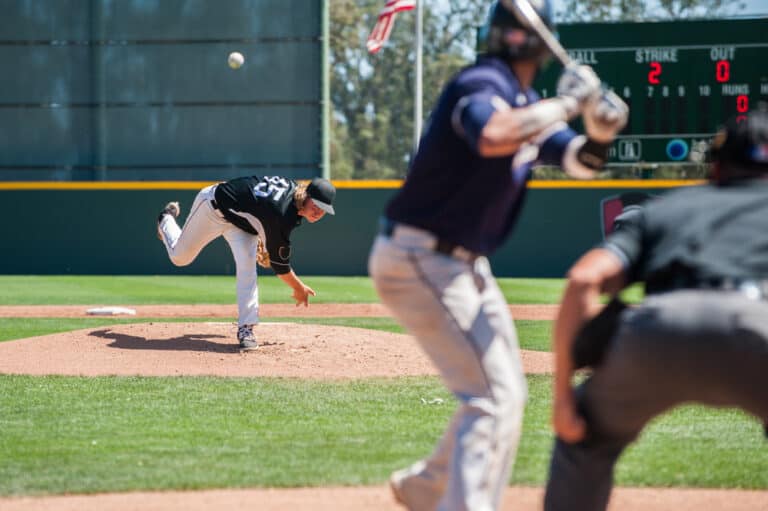Penalty For Running On MLB Field (Hint: Don’t Do It)
Editorial credit: Eric Broder Van Dyke / Shutterstock.com
On May 13, 2011, a man became a legend at Minute Maid Park. But he wasn’t an MLB player. Instead, he was a fan who ran across the field and then used Tal’s Hill (RIP) to make his great escape. Many dreams of running across a professional sports field, but few do it, and almost everyone gets caught. But what happens next?
The penalty for running on an MLB field is a lifetime ban from the venue. In addition, depending on the US state where the event occurred, the fan could be charged with criminal trespass, spend a night in jail, fined, and possibly have to go to court with the possibility of going to prison.
At first glance, the penalties for running across a pro sports field seem over-the-top. But what if it happened every inning? Would fans enjoy it then? Then there is the shocking event of February 6, 2022, at a professional soccer match. A Leicester City fan came onto the field, attacking Nottingham Forest players. But these days, even the tradition of rushing the field has ended. Why?
Why The Penalty For Running On An MLB Field Varies
Aside from the venue ban, the penalty for running on an MLB isn’t universal. One of the reasons is that the offense is typically classified as trespassing. But trespassing comes in various forms, and state and city laws are not universal, and Canada, of course, has their own rules.
A typical fan running across the field with no malicious intent will usually fall into the misdemeanor category of trespassing. Depending on various factors, including where it happened, the fine will range from 75-1,000 dollars. It may even carry up to six months in jail. However, if the fan is charged with aggravated trespass, it is a felony, with prison time ranging from 16 months to three years.
Adding to the issue is that many stadiums are paid for in part by local taxpayers. But just because a person’s tax dollars went into a project doesn’t mean the taxpayer has carte blanche access. Thus, the field can be classified as city property, making the offender liable for other fines and consequences.
New York City’s Calvin Klien Law
The New York City Calvin Klien Law is one of the best examples of how penalties vary. Mayor Bloomberg signed the law in October 2003, which makes it trespassing for fans to come onto courts or playing fields during any major sporting event. It carries the potential fines of up to 25,000 dollars and twelve months in jail.
The inspiration for the law had nothing to do with the MBL, although they were supporters of the bill. Instead, the event that kicked things off occurred during a Knicks game when the fashion designer strolled onto the NBA court and whispered something to Latrell Sprewell.
To be clear, Sprewell wasn’t hurt nor pressed for a new law. He didn’t even share what was whispered in his ear, stating, “I’m going to keep that to myself.” Instead, the justification for the law was concern that fans could become “unruly” and hurt a player.
Why MBL Fans Can No Longer Rush The Field
On October 21, 1980, baseball fans became banned from rushing the field. Thus, the penalties for doing so are much like running across the field during a game. Until then, it was a tradition for fans to flood the field after the home team won the Pennant or the World Series.
Yet, the ban didn’t come out of concern for players’ safety, although, in retrospect, many defend it as such. Nor did they do it because it causes interference, even though it had.
For example, there is a joke that Chris Chambliss is still trying to touch home plate after making the 1976 homerun that clinched the Pennant for the Yankees. The crowd was too thick and kept knocking him down in their euphoria. Eventually, a human chain was formed, and Chambliss was led back to the field through the cheering mob, so he could officially touch the plate.
Instead, the reason for the ban is money. As stadiums became built with taxpayer dollars, the cost of upkeep and policing them also fell onto the taxpayer. Consequently, city administrators started to fear high repair bills that resulted from the damage fans caused when they took to the field. So, they made coming onto the field uninvited trespassing, even after the game was finished.
Are The Penalties For Running On An MLB Field Effective?
The penalties for running across an MLB field appear to be pretty effective. Social media is full of people claiming they’d love to pull the stunt, yet the occurrences are rare. But the most interesting is why all those streaker-dreams resist claiming their moment of fame.
If the fans’ chatter is to be believed, it isn’t the threat of fines or jail time that holds them back. Instead, it is the thought of being banned from the venue that hosts their beloved team. The idea of being confined to only witnessing games through a television keeps them in the stands. Usually.
However, a Toronto Blue Jays fan that ran across the field says there is more to consider than the stated consequences.
The Hidden Penalties For Running On An MLB Field
There is a reason the Minute Maid Park great escape is legendary: fans who run across an MLB field get caught. Even the fan hero who climbed Tal’s Hill is said to have eventually been tracked down and arrested. But what happens after a fan is hauled away?
Well, one fan started a blog to document his brief moment of fame. On May 5, 2013, the man ran across the field at the Rogers Centre as the Toronto Blue Jays played the Seattle Mariners. The man was promptly caught, but he has been very clear he was not mistreated by the Toronto Police.
By all accounts, the Toronto Police were highly amused and treated the fan well. Their write-up of the events even made headlines. The statement opens with “[A]t approximately 3:18 PM the Toronto Blue jays [sic] were surprisingly winning against the underrated Seattle Mariners. Our hapless Jays limped along to the bottom of the 8th inning.” They go on to state, “One can almost forgive the accused for his below-described actions.”
However, the fan is clear that nobody should try to do what he did despite the police officers having a sense of humor and the charges eventually being dropped.
For starters, he still had to go through procedures, which included a strip search and being held in a cell as the paperwork was processed. He also points out that events would have been much worse had he been naked or had exposed himself.
But even though he “got away” without charges, it still cost him plenty. This is because he still had to attend court, which cost him time and hassle. It also meant he had to hire a criminal defense attorney, who charges a fair bit more than the Federal minimum wage for their services. Thus, his stunt cost him a significant amount of cash.

Conclusion
Running onto an MLB field can have various consequences, depending on where the event occurred, if the fan was dressed, and the perceived intent behind the fan’s actions (i.e., assault is a much bigger deal than a prank). But if fans are to be believed, high fines and jail time are not what is keeping them in their seats. Instead, it is their love of the game.
References
- https://www.thelist.com/329266/what-happens-if-you-get-caught-running-on-the-field-at-the-super-bowl/
- https://www.youtube.com/watch?v=-mQcOriUu94
- https://www.sbnation.com/2011/5/14/2170984/astros-fan-ran-on-field-video
- https://slate.com/culture/2020/10/world-series-fans-rush-field-baseball-tradition-lost.html
- https://www.criminaldefenselawyer.com/crime-penalties/federal/Tresspassing.htm







